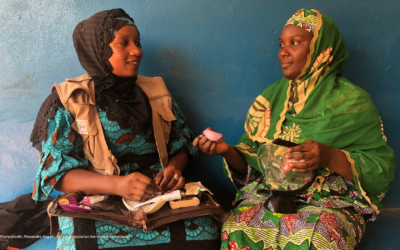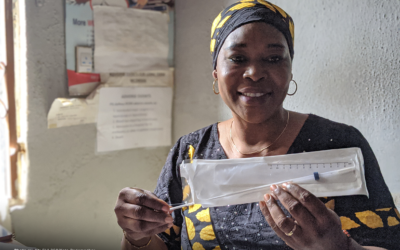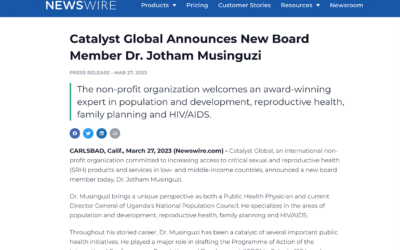The Need for New Options
Worldwide, women can relate to the struggle of finding a contraceptive method that fits their needs and preferences. The research shows that women often try several products before finding one that works for them for now, and then repeat the search when their situation changes – be it shifts in their health or relationship status, or once they’ve reached their desired family size.
But that’s only half the story – for 218 million women and adolescent girls want to prevent pregnancy but are not using any modern contraceptive method. They are still searching for the “right” contraceptive method, have not begun to look, or have given up altogether.
Contraceptive markets are failing these women and girls. As part of comprehensive efforts to strengthen health markets, advances in contraceptive technology are needed.
Led by WCG Cares in partnership with PSI, USAID’s Expanding Effective Contraceptive Options (EECO) project supports pilot introductions of promising contraceptive methods in countries where they are not yet available. EECO works to introduce not only novel contraceptive technologies, but also new generations of familiar methods—products redesigned to address the concerns and priorities of those whose contraceptive needs are yet to be met.
Reworking “Old” Methods
Across 47+ countries, health concerns (including side effects) and infrequent sex rank as women’s top reasons for not using contraception.
This presents an opportunity for innovation.
Consumer research shows that many women and girls desire more non-hormonal contraceptive choices and more “on-demand” options that can be used only when needed rather than continuously. These (among other) insights have led product developers to take a fresh look at “old” contraceptives and adapt them to appeal to those not using contraception while still in need.
These redesigned methods respond to user concerns (e.g., reducing side effects, making them easier to use), while creating an opportunity to refresh brands and marketing, and pitch the new features as something worth trying – just as Apple releases a new iPhone model every year.
Of course, refining existing methods does not replace the need to discover and develop novel contraceptive technologies, but it can accelerate efforts to expand the range of options that respond to both consumer preferences and health system realities.
Market Responses to Redesigned Methods
How do consumers respond to improvements on existing contraceptives? Here are three examples from the EECO project.
1. A Single-Size Diaphragm

Diaphragms were once the most commonly used contraceptive method in many countries, but popularity declined in the second half of the 20th century as hormonal contraceptives and intrauterine devices (IUDs) became available. Still many women voiced a desire for more contraceptive options without side effects such as menstrual changes. In response, PATH employed a user-centered process to develop the Caya® contoured diaphragm, launched in 2014 and now marketed in nearly 40 high- and middle-income countries.
Caya addresses key drawbacks of earlier generation diaphragm models. Traditional diaphragms come in multiple sizes and require a pelvic exam to determine which size a woman can wear. In contrast, Caya’s single size fits most women which eliminates the need for a fit exam by a health provider and makes the product simpler to supply and provide—especially in resource-constrained settings. Moreover, some women found traditional diaphragms difficult to insert or uncomfortable to wear. Women and their partners typically find Caya comfortable and easy to use thanks to design improvements over older models.
The USAID Expanding Effective Contraceptive Options (EECO) project led a pilot introduction of Caya in Niger, exploring uptake and acceptability of the method in a setting with one of the lowest rates of modern contraceptive use in the world. More than 1000 women adopted Caya within the first 15 months of service delivery through community health workers and providers in the public and private sectors in Niamey, Niger. Women reported that they like this self-care method because it has no side effects, is used only when needed, and is reusable for up to two years. Many Caya adopters in Niger report infrequent sex, suggesting that this on-demand, non-hormonal method may have the potential to meet the needs of others around the world who cite “infrequent sex” as their reason for non-use of contraception.
2. An IUD with Different Menstrual Effects

Period changes affect contraceptive preferences, but not in the same way for everyone. Women vary widely in their perspectives on the diverse menstrual bleeding changes that can result from some hormonal contraceptive methods and copper IUDs. Copper IUD users tend to experience heavier or longer menstrual periods early in use, with menses typically returning to the user’s normal pattern over time. For many women, these changes are acceptable and preferable to the irregular or absent periods typically induced by contraceptive injectables and implants. For other women, lighter or absent periods would be a dream.
More than 30 years ago, the Population Council built upon the classic copper IUD model, developing an alternative IUD that offers the same highly-effective, long-acting, safe, and reversible contraception as the copper IUD with different menstrual effects. The resulting levonorgestrel intrauterine system, also called the hormonal IUD, can also be used as treatment for gynecological conditions such as menorrhagia (abnormally heavy or lengthy periods). Like the copper IUD, the hormonal IUD is a small T-shaped device placed in the uterus. After an initial period of spotting, hormonal IUD users commonly experience light, infrequent periods or no periods at all. Some women prefer the experience of using the hormonal IUD and others prefer the copper IUD, which remains a staple of family planning programs.
Although the hormonal IUD has been available in high-income countries for several decades, access is currently limited in LMICs. EECO led pilot introductions of the hormonal IUD in Madagascar and Zambia. The project found that women who chose the hormonal IUD did not see the method as interchangeable with the copper model; most said they would have chosen a short-acting method or no modern method at all if the hormonal IUD hadn’t been available. In addition, many chose the hormonal IUD specifically because it offers reduced or no periods. Thanks in large part to market shaping efforts by a coalition of partners called the Hormonal IUD Access Group, USAID has added hormonal IUD products to their procurement systems for the first time—a major milestone along the road to expanded method choice. UNFPA is in the process of doing the same.
Thanks in large part to market shaping efforts by a coalition of partners called the Hormonal IUD Access Group, USAID has added hormonal IUD products to their procurement systems for the first time—a major milestone along the road to expanded method choice.
3. A redesigned female condom

In the 1980s, product developers designed female condoms as a woman-controlled alternative to male condoms, aiming to put more power into the hands of women and girls to prevent unintended pregnancy, HIV, and other STIs. Multiple generations of female condoms have entered the market with changes in appearance, ease of use, sound, fit, and feel. PATH developed the most recent iteration, the Woman’s Condom, through its user-centered design process.
When EECO launched the Woman’s Condom in Malawi (branded “Whisper”) and Zambia (branded “Maximum Diva”), many women not only tried but continued with the product for the duration of the 15-month pilot. Women and adolescent girls reported that it was much easier to insert and was softer and quieter than other models they had used in the past. Creative marketing and distribution through promotion teams in Malawi, for example, resulted in reports from those who had used the product that they did so because they were interested in a “new” product, attracted to the features such as the ease of insertion and the lubricant sachet, desired dual protection against HIV/STIs and pregnancy, and drawn to the packaging. Overall, the women who used Whisper reported a high level of satisfaction and willingness to recommend the product.
Looking Ahead
Creative approaches to breathe new life into old methods have added exciting opportunities that may help close the gap between contraceptive need and use. And in the world of women’s reproductive health, a robust contraceptive method mix has long been seen as critical: more method choices, more unique features, and greater affordability to support women to find products that they like, accommodating their changing needs throughout their reproductive years.
For guidance on how to introduce contraceptive products like these into new markets, join the EECO project, PATH, Population Council, FHI 360, and CHAI during a session on “The Highs, Lows, and Squishy Middle of Contraceptive Product Introduction” at the Global Health Science and Practice Technical Exchange (GHTechX) on April 22, 2021. Learn more about where PSI will be during GHTechX.




